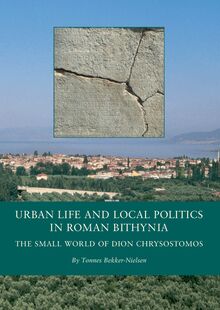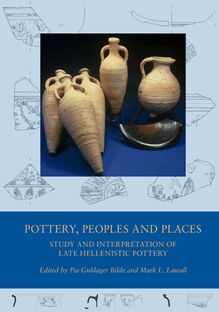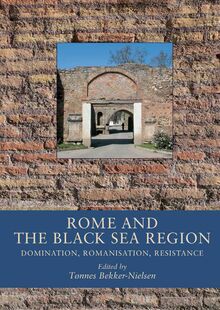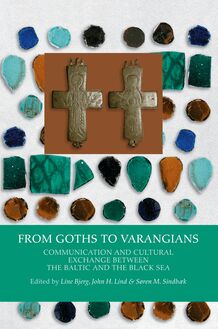Urban Life and Local Politics in Roman Bithynia , livre ebook
120
pages
English
Ebooks
2008
Vous pourrez modifier la taille du texte de cet ouvrage
Obtenez un accès à la bibliothèque pour le consulter en ligne En savoir plus
Découvre YouScribe en t'inscrivant gratuitement
Découvre YouScribe en t'inscrivant gratuitement
120
pages
English
Ebooks
2008
Vous pourrez modifier la taille du texte de cet ouvrage
Obtenez un accès à la bibliothèque pour le consulter en ligne En savoir plus
Publié par
Date de parution
01 septembre 2008
Nombre de lectures
0
EAN13
9788771247527
Langue
English
Poids de l'ouvrage
6 Mo
Publié par
Date de parution
01 septembre 2008
Nombre de lectures
0
EAN13
9788771247527
Langue
English
Poids de l'ouvrage
6 Mo
BLACK SEA STUDIES
7
THE DANISH NATIONAL RESEARCH FOUNDATION S CENTRE FOR BLACK SEA STUDIES
T nnes Bekker-Nielsen
URBAN LIFE AND LOCAL POLITICS IN ROMAN BITHYNIA
THE SMALL WORLD OF DION CHRYSOSTOMOS
Preface
My first meeting with Dion Chrysostomos took place on a rainy winter s evening in the Classics Library of the University of Bergen. While searching for another text, I came across one of Dion s municipal speeches. This chance encounter led to a deeper interest in this small-town politician. Some years later, the opportunity for a closer study of Dion and his urban environment presented itself as part of a research project on Greeks under the Roman Empire under the auspices of the Danish National Research Foundation s Centre for Black Sea Studies.
Within the Centre for Black Sea Studies, I had the good fortune to work with Jesper Majbom Madsen as supervisor of his Ph.D. thesis, soon to be published as Eager to be Roman (Duckworth, 2008). Together, we organized a workshop on Rome and the Black Sea Region (the proceedings of which were published in 2006 as volume 5 of Black Sea Studies ) and another about Dion himself (published in Danish as Dion af Prusa: En gr sk intellektuel mellem Rom og Sortehavet , 2007).
I am also grateful for the chance to discuss different aspects of Bithynian life under the Roman Empire with other friends and colleagues, especially Pia Guldager Bilde, Jesper Carlsen, Thomas Corsten, George Hinge, Marit Jensen, J rgen Christian Meyer, Eckart Olshausen, Rita Rattenborg, Helle Sejersen, Christian Winkle and Greg Woolf, and with students following courses on Roman Bithynia at the University of Southern Denmark, Esbjerg (2004) and the University of Stuttgart (2007). Thanks are also due to the staff of Konuralp and greater Izmit municipalities, and of the National Archaeological Museum, Istanbul as well as the municipal archaeological museums of Bursa, Izmit, Iznik and Konuralp for their assistance.
Kolding, January 2008
T nnes Bekker-Nielsen
List of Illustrations
1. Map of Roman Bithynia (Inger Bjerg Poulsen)
2a. Nikaian bronze coin showing the city s founder, Dionysos, returning from India in an elephant quadriga (Tom Vossen)
2b. Prusan bronze coin showing Prusias, the founder of Prusa (American Numismatic Society)
3a. Nikomedian bronze coin of the reign of Commodus (Gorny Mosch, Giessener M nzhandlung)
3b. Nikomedian bronze coin of Philip the Arab, showing a square-rigged ship (Alexandre de Barros collection)
4. The southern wall of Prusa (author s photo)
5. Nikaia seen from the east (author s photo)
6. Detail of the Tabula Peutingeriana (Staatsbibliothek, Vienna)
7a. Bronze coin of the Bithynian koinon , struck under Hadrian (M nzen und Medaillen Deutschland)
7b. Nikomedian bronze coin of Valerian, Gallienus and Valerian II (Classical Numismatic Group)
8. Map of Nikaia (Inger Bjerg Poulsen)
9. Remains of the southern wall of Nikomedia s citadel in the Medrese Sokak (author s photo)
10. The course of the late antique east wall (author s photo)
11. Map of Nikomedia (Inger Bjerg Poulsen)
12. Map of Prusa (Inger Bjerg Poulsen)
13. Gate 6 may be a remnant of Nikaia s Hellenistic defense perimeter (author s photo)
14. A negative impression of the Hadrianic walls of Nikaia (author s photo)
15. North (Istanbul) gate of Nikaia seen from the inside (Jesper Majbom Madsen)
16. Elevation of the North (Istanbul) gate of Nikaia (Dalman, Fick Schneider 1938)
17. The east (Lefke) gate of Nikaia, seen from the outside (author s photo)
18. The sarcophagus of Aurelius Vernicianus and his wife Markiane. Izmit museum (author s photo)
19. Inscription honouring the emperor Trajan, dedicated by the city secretary ( grammateus ) T. Flavius Sil n. Bursa Museum (author s photo)
20. Unfinished inscription, now in the garden of Bursa Museum (author s photo)
21. Inscription in honour of Marcus Domitius Paulianus Falco in the ancient theatre of Konuralp (author s photo)
22. The obelisk-like monument of the Nikaian notable Cassius Philiskos (author s photo)
23. Detail of the monument, showing recesses in the side of the vertical stone face (author s photo)
24. Inscription on the rear face of the monument giving the name, age and filiation of Cassius Philiskos (author s photo)
25. The inscription over the east (Lefke) gate of Nikaia. At the end of the second line, the name of Cassius Chrestos in the genitive (author s photo)
26. The sarcophagus of C. Cassius Chrestos in the garden of Iznik Museum (author s photo)
27. Seated statue of a philosopher, Bursa museum (author s photo)
28. Prusan notable of the Roman period. Bursa museum (author s photo)
29. The theatre of Nikaia (Jesper Majbom Madsen)
30. Sesterce from the mint of Rome. The reverse shows the tych of the city kneeling before the emperor Hadrian, restitutor Nicomediae (Leu Numismatik AG)
31. The biography of Flavius Severianus Asklepiodotos, a rich notable of Nikaia in the early third century. Iznik Museum (author s photo)
32. Despite later reconstructions and repair work, the still standing third-century walls of Nikaia give a good impression of the defences of a late Roman city (author s photo)
33. The south gate of Nikaia (author s photo)
34a. Nikaian coin of Gallienus (AD 253-268) showing the new walls of Nikaia, with large towers flanking the gates (Numismatik Lanz, Munich)
34b. Nikaian coin from the brief reign of Macrianus (AD 260-261) showing a similar bird s eye view of Nikaia (Classical Numismatic Group)
35. Justinian s bridge west of Nikaia (Jesper Majbom Madsen)
1. Introduction
The ancient world as we know it would be unthinkable without the city. The world of classical Greece was a world of city-states; the Roman Empire was an empire of cities. From the fourth century BC onwards, most cities were no longer sovereign, self-governing poleis , but they were still governing on behalf of their Hellenistic or Roman rulers. The administrative functions of the city and the readiness of its elite to participate in its administration were crucial to the success of, and crucial to our understanding of, the Roman imperial project.
Hybris and stasis
Aristotle famously defined man as a politikon z on , 1 sometimes translated as a political animal and sometimes as a creature that lives in cities . The exact meaning lies somewhere between the two: man is not political in the modern sense of the English word, but neither is he merely a city-dweller. It would be clumsier, but perhaps more precise to translate politikon z on as a being that participates in a city . To our eyes, ancient Greek cities were characterised by a high degree of citizen participation in the political process, not only because it was perceived as the duty of an adult male citizen, but also because it provided an opportunity for public display of positive personal qualities.
For the majority of the male citizens, a large part of the day was spent in public spaces: the street, the agora , the gymnasium, and a correspondingly smaller part within the confines of the nuclear family, the dwelling or the workplace. The public nature of the social environment favoured the creation of an agonistic urban society where the place of the individual within the group and within the citizen body was continually being defined and redefined through ties of family, friendship, loyalty, patronage and clientage, and where visible personal qualities (honour, face , bearing, speech, education) were very important, tangible but impersonal status markers (wealth, possessions) less important. As the Book of Proverbs expresses it: a good name is more desirable than great riches; to be esteemed is better than silver or gold . 2
The social environment of a Greek city thus placed the male individual in a sink-or-swim situation: his status or honour had to be displayed on a regular basis, marking his place within the social hierarchy of the community and enabling him to establish advantageous long-term relationships of patronage, clientage, friendship or marriage. On the other hand, the city was not a social jungle where one animal ate another: the ag n took place within a restraining framework of written and unwritten rules, ensuring that conflicts rarely got out of hand. Two central concepts in this connection are hybris and stasis .
The familiar meaning of hybris is intolerable arrogance but in a wider sense, hybris encompasses violent or anti-social behaviour in general. Sailing off to explore the land of the Cyclopes, Odysseus desires to know what manner of men live there, whether they are arrogant men ( hybristai ) that do not have laws, or kind to strangers ( philoxenoi ) and god-fearing in their hearts . 3 The form of life that he finds there is the exact antithesis of the civilized urban lifestyle: the Cyclops lives alone in his cave, follows no laws and does not fear the gods. As if to underline his disregard for Greek norms of social behaviour, which emphasize hospitality to strangers, the Cyclops not only treats his guests badly; he eats them.
Arrogant and self-gratifying behaviour transgressing established norms of social behaviour could not be tolerated within the polis , since it threatened the social cohesion and solidarity of the community, which was vital for survival in a conflict with other poleis . Another threat was stasis , disruptive conflict within the community, which could take the form of extreme factionalism or actual political violence. In the Politics , the clinching argument of Aristotle in favour of his middle constitution is that it is free from stasis ( astasiaskos ) 4 and according to the Memorabilia of Xenophon, Sokrates defined the good



